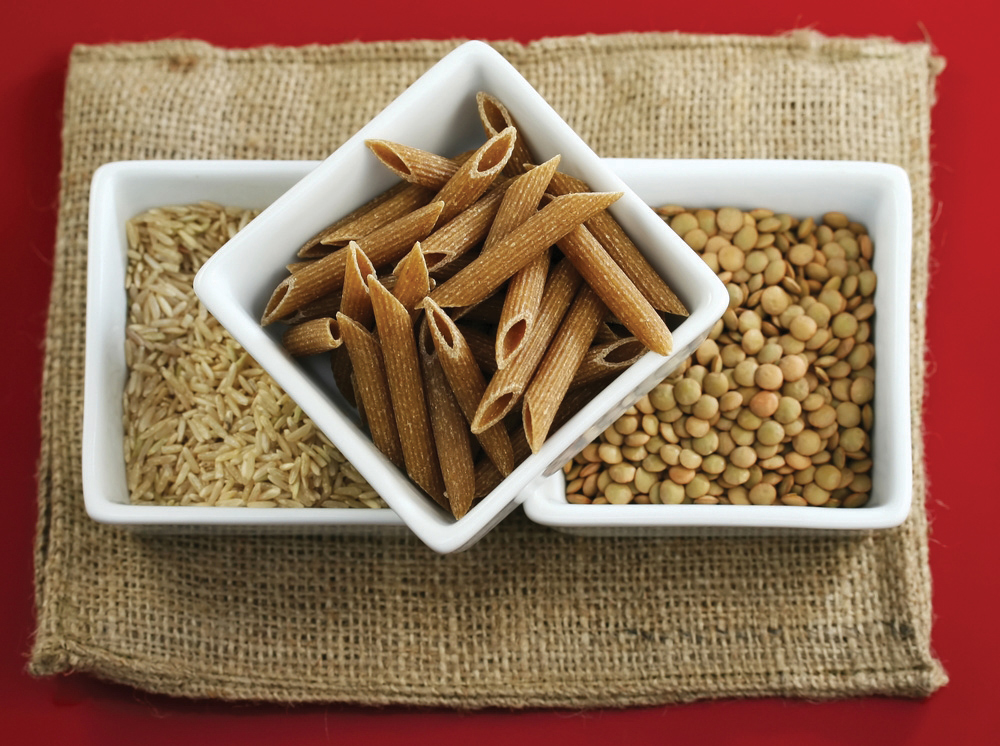This is “Recommendations for Optimal Health”, section 2.5 from the book An Introduction to Nutrition (v. 1.0). For details on it (including licensing), click here.
For more information on the source of this book, or why it is available for free, please see the project's home page. You can browse or download additional books there. To download a .zip file containing this book to use offline, simply click here.
2.5 Recommendations for Optimal Health
Learning Objectives
- Design a quality diet plan using MyPlate Daily Food Plan.
- State recommendation(s) for fruit and vegetable consumption and list the potential benefits of this eating program.
For many years, the US government has been encouraging Americans to develop healthful dietary habits. In 1992 the food pyramid was introduced, and in 2005 it was updated. This was the symbol of healthy eating patterns for all Americans. However, some felt it was difficult to understand, so in 2011, the pyramid was replaced with Choose MyPlate.
The Choose MyPlate program uses a tailored approach to give people the needed information to help design a healthy diet. The plate is divided according to the amount of food and nutrients you should consume for each meal. Each food group is identified with a different color, showing the food variety that all plates must have. Aside from educating people about the type of food that is best to support optimal health, the new food plan offers the advice that it is okay to enjoy food, just eat less of it.US Department of Agriculture. Accessed July 22, 2012. http://www.choosemyplate.gov/.
Video 2.4
Introducing the New Food Icon: MyPlate
(click to see video)This video provides an introduction to the new MyPlate food guide.
Building a Healthy Plate: Choose Nutrient-Rich Foods
Planning a healthy diet using the MyPlate approach is not difficult. According to the icon, half of your plate should have fruits and vegetables, one-quarter should have whole grains, and one-quarter should have protein. Dairy products should be low-fat or non-fat. The ideal diet gives you the most nutrients within the fewest calories. This means choosing nutrient-rich foods.
Fill half of your plate with red, orange, and dark green vegetables and fruits, such as kale, collard greens, tomatoes, sweet potatoes, broccoli, apples, oranges, grapes, bananas, blueberries, and strawberries in main and side dishes. Vary your choices to get the benefit of as many different vegetables and fruits as you can. You may choose to drink fruit juice as a replacement for eating fruit. (As long as the juice is 100 percent fruit juice and only half your fruit intake is replaced with juice, this is an acceptable exchange.) For snacks, eat fruits, vegetables, or unsalted nuts.
Fill a quarter of your plate with whole grains such as 100 percent whole-grain cereals, breads, crackers, rice, and pasta. Half of your daily grain intake should be whole grains. Read the ingredients list on food labels carefully to determine if a food is comprised of whole grains.
Tools for Change
Consider the information in this video:
Buying Local: The Importance of Locally Produced and Organically Grown Foods to Local Economy
Identify which vegetables and fruits are in season and local to your area. By consuming in-season, local foods you cut down on transportation costs (emission and financial) and you are likely to get fresher produce. You also support your local farms by purchasing their produce.

Make sure at least half of your daily grain intake comes from whole-grain foods.
© Shutterstock
Select a variety of protein foods to improve nutrient intake and promote health benefits. Each week, be sure to include a nice array of protein sources in your diet, such as nuts, seeds, beans, legumes, poultry, soy, and seafood. The recommended consumption amount for seafood for adults is two 4-ounce servings per week. When choosing meat, select lean cuts. Be conscious to prepare meats using little or no added saturated fat, such as butter.

Remember to vary your selections of protein. Lentils contain good amounts of protein and make great meals. Try using lentils or beans as a meat substitute each week.
© Thinkstock
If you enjoy drinking milk or eating milk products, such as cheese and yogurt, choose low-fat or nonfat products. Low-fat and nonfat products contain the same amount of calcium and other essential nutrients as whole-milk products, but with much less fat and calories. Calcium, an important mineral for your body, is also available in lactose-free and fortified soy beverage and rice beverage products. You can also get calcium in vegetables and other fortified foods and beverages.
Oils are essential for your diet as they contain valuable essential fatty acids, but the type you choose and the amount you consume is important. Be sure the oil is plant-based rather than based on animal fat. You can also get oils from many types of fish, as well as avocados, and unsalted nuts and seeds. Although oils are essential for health they do contain about 120 calories per tablespoon. It is vital to balance oil consumption with total caloric intake. The Nutrition Facts label provides the information to help you make healthful decisions.
In short, substituting vegetables and fruit in place of unhealthy foods is a good way to make a nutrient-poor diet healthy again. Vegetables are full of nutrients and antioxidants that help promote good health and reduce the risk for developing chronic diseases such as stroke, heart disease, high blood pressure, Type 2 diabetes, and certain types of cancer. Regularly eating fresh fruits and vegetables will boost your overall health profile.
Discretionary Calories
When following a balanced, healthful diet with many nutrient-dense foods, you may consume enough of your daily nutrients before you reach your daily calorie limit. The remaining calories are discretionary (to be used according to your best judgment). To find out your discretionary calorie allowance, add up all the calories you consumed to achieve the recommended nutrient intakes and then subtract this number from your recommended daily caloric allowance. For example, someone who has a recommended 2,000-calorie per day diet may eat enough nutrient-dense foods to meet requirements after consuming only 1,814 calories. The remaining 186 calories are discretionary. These calories may be obtained from eating an additional piece of fruit, adding another teaspoon of olive oil on a salad or butter on a piece of bread, adding sugar or honey to cereal, or consuming an alcoholic beverage.US Department of Agriculture. “MyPyramid Education Framework.” Accessed July 22, 2012. http://www.choosemyplate.gov
The amount of discretionary calories increases with physical activity level and decreases with age. For most physically active adults, the discretionary calorie allowance is, at most, 15 percent of the recommended caloric intake. By consuming nutrient-dense foods, you afford yourself a discretionary calorie allowance.
Table 2.6 Sample Menu Plan Containing 2,000 Calories
| Meal | Calories | Total Meal/Snack Calories |
|---|---|---|
| Breakfast | ||
| 1 scrambled egg | 92 | |
| with sliced mushrooms and spinach | 7 | |
| ½ whole-wheat muffin | 67 | |
| 1 tsp. margarine-like spread | 15 | |
| 1 orange | 65 | |
| 8 oz. low-sodium tomato juice | 53 | 299 |
| Snack | ||
| 6 oz. fat-free flavored yogurt | 100 | |
| with ½ c. raspberries | 32 | 132 |
| Lunch | ||
| 1 sandwich on pumpernickel bread | 160 | |
| with smoked turkey deli meat, | 30 | |
| 4 slices tomato | 14 | |
| 2 lettuce leaves | 3 | |
| 1 tsp. mustard | 3 | |
| 1 oz. baked potato chips | 110 | |
| ½ c. blueberries, with 1 tsp. sugar | 57 | |
| 8 oz. fat-free milk | 90 | 467 |
| Snack | ||
| 1 banana | 105 | |
| 7 reduced-fat high-fiber crackers | 120 | 225 |
| Dinner | ||
| 1 c. Greek salad (tomatoes, cucumbers, feta) | 150 | |
| with 5 Greek olives, | 45 | |
| with 1.5 tsp. olive oil | 60 | |
| 3 oz. grilled chicken breast | 150 | |
| ½ c. steamed asparagus | 20 | |
| with 1 tsp. olive oil, | 40 | |
| with 1 tsp. sesame seeds | 18 | |
| ½ c. cooked wild rice | 83 | |
| with ½ c. chopped kale | 18 | |
| 1 whole-wheat dinner roll | 4 | |
| with 1 tsp. almond butter | 33 | 691 |
| (Total calories from all meals and snacks = 1,814) | ||
| Discretionary calorie allowance: 186 | ||
Healthy Eating Index
To assess whether the American diet is conforming to the 2010 Dietary Guidelines, the Center for Nutrition Policy and Promotion (CNPP), a division of the USDA, uses a standardized tool called the Healthy Eating Index (HEI)A standardized tool based on a simple scoring system of dietary components used to assess whether the diets of Americans are improving and adhering to the dietary guidelines..US Department of Agriculture. “Healthy Eating Index.” Last modified March 14, 2012. http://www.cnpp.usda.gov/healthyeatingindex.htm. The first HEI was developed in 1995 and revised in 2006. This tool is a simple scoring system of dietary components. The data for scoring diets is taken from national surveys of particular population subgroups, such as children from low-income families or Americans over the age of sixty-five. Diets are broken down into several food categories including milk, whole fruits, dark green and orange vegetables, whole grains, and saturated fat, and then a score is given based on the amount consumed. For example, a score of ten is given if a 2,000-kilocalorie diet includes greater than 2.6 cups of milk per day. If less than 10 percent of total calories in a diet are from saturated fat, a score of eight is given. All of the scores are added up from the different food categories and the diets are given a HEI score. Using this standardized diet-assessment tool at different times, every ten years for instance, the CNPP can determine if the eating habits of certain groups of the American population are getting better or worse. The HEI tool provides the federal government with information to make policy changes to better the diets of American people. For more information on the HEI, visit this website: http://www.cnpp.usda.gov/healthyeatingindex.htm.
Key Takeaways
- The Food Pyramid has been replaced by MyPlate, a system that was designed to be easier to implement. The new MyPlate encourages all plates to be filled with fruits and vegetables (50 percent), protein (25 percent), and grains (25 percent). Half of daily grain intake should be from whole-grain sources. Dairy choices should be switched to low-fat or non-fat sources.
- A diet rich in fresh fruits and vegetables will help you lose and/or maintain weight, will lower your risk for stroke, heart disease, high blood pressure, Type 2 diabetes, and certain types of cancer, and will boost your overall health profile.
- By choosing nutrient-dense foods, you may have discretionary calories to “spend” at the end of the day.
Discussion Starter
- As you analyze the new MyPlate, how do your regular dietary habits compare to this new format? What changes, if any, will you have to make to your breakfast? Lunch? Dinner?




